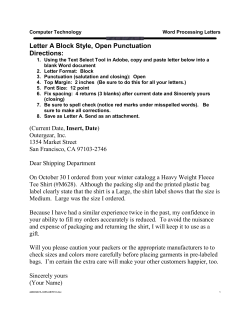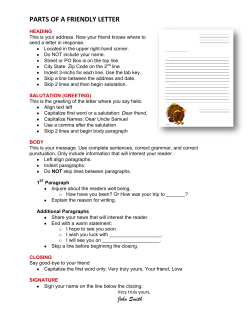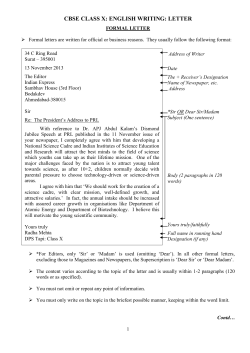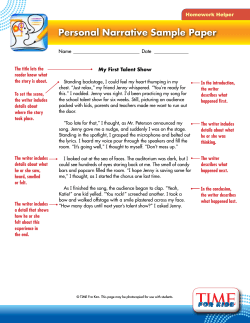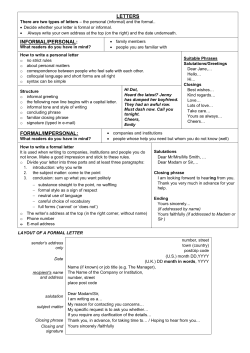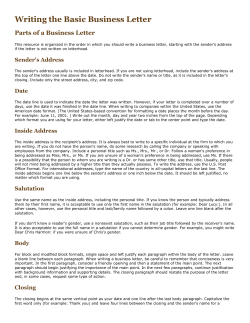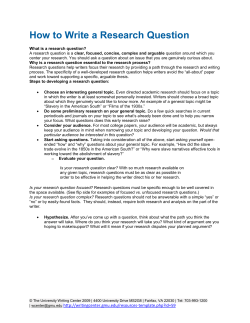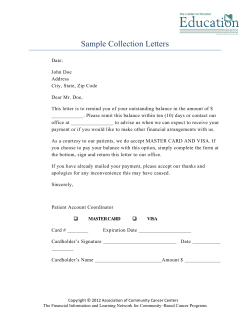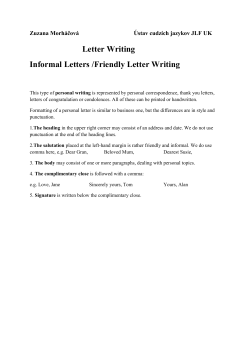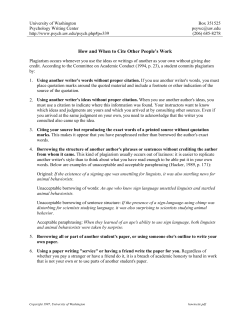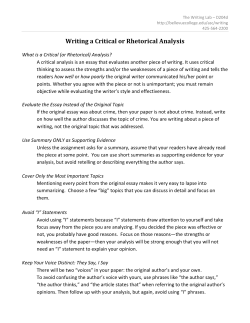
GOAL: Write A Letter Introduction
GOAL: Write A Letter Contributed by Stephanie Allen Sacramento Public Library Introduction Writing a letter may seem like a lost art since so much written communication is accomplished through e-mail today. However it is still a skill that is useful in certain situations: in business (like a cover letter to a resume') or any time you would like to be more formal. There are many different types of letters, each appropriate for different purposes. Many of us hesitate to write a letter, feeling that we may not know where to begin, or the ‘proper’ or ‘correct’ way to write it. It can feel intimidating, but shouldn’t be, since it is simply putting your thoughts down on paper. Think of a letter as simply your thoughts in written form. Getting Started Before you get started, you’ll need to decide what kind of letter you want to write. You’ll need to think about three main things: 1.) the type of letter (personal or business); 2.) the intended audience; and, 3.) the purpose of the letter. Two of the easiest letters to start with are a personal (friendly) letter and a thank-you letter. Other common types of letters include recommendation and cover letters. Once you’ve decided on the type of letter you want to write, you’ll need to think about the parts of that letter. Depending on the type of letter, it can be very simple, such as a short personal note or thank-you letter. Others, such as reference or recommendation letters, will be a bit more complex. Goal: Write a Letter Books & Resources Books Writing to Others – Will give you practice with everyday writing in real-life situations. Includes lessons on writing notes and invitations, business letters and resumes, want ads, e-mails, blogs, and more! Published by New Readers’ Press. Letter-Writing Made Easy Vols. 1 & 2 -- Includes hundreds of ready-to-use samples for personal and business letters. Published by Santa Monica Press. Websites www.bestsampleletters.com www.letterwritingguide.com Key Vocabulary Vocabulary may vary depending on the type of letter you are writing, but here are some of the most common terms used to describe the different parts of a letter: • Heading: The heading can include the address and the date. In casual, friendly letters, your address is usually not necessary. • Salutation (Greeting): The salutation usually starts with Dear and is followed by the person’s name and then a comma. • Body: The body is the main text of your letter. It contains the thoughts and ideas you want to share. • Closing: The closing is a way to end the letter and to say good-bye. Common closing expressions include Sincerely, Love, or Your Friend. • Signature: The signature is the final part of a personal or friendly letter. It is your name written directly beneath the closing. It is usually written in cursive writing. 2 Goal: Write a Letter Parts of a Friendly or Personal Letter The HEADING can include your address and the date. In casual, friendly letters your address is not necessary. The SALUTATION is a greeting. It usually begins with Dear_________. The blank is for the name of the person you are writing. After you write the person's name you put a comma ( , ) . 123 Elm Street Elmsville, CA 12345 May 21, 2011 Dear Jane Doe, The body of the letter contains the thoughts and ideas you want to share with the person to whom you are writing. Sincerely, The BODY of the letter contains all of the information you are writing in your letter. John Doe The SIGNATURE is your name. It goes under the closing and should be written in cursive. The CLOSING is a way to end the letter. Skip a line and write your closing. The first word is capitalized and you put a comma after the last word. Here are some examples of common closings: Love, Sincerely, Yours Truly, Your Friend, 3 Goal: Write a Letter Reading Practice n Sampler. Learn by reading sample letters. There are numerous sample letters available online. Check out www.bestsampleletters.com or www.letterwritingguide.com and print out a selection. See if you can figure out 1.) the type of letter (personal or business); 2.) the intended audience (private? public? other?); and, 3.) the purpose of the letter. n Newspaper. Try reading the ‘Letters to the Editor’ section in your local newspaper. Why was the letter written? Did the writer have a concern? a complaint? a compliment? or some other reason? If you were the editor, how would you respond? n Historic Letters. At your local library, you can find books containing collections of letters written by famous people in history. Here is one suggestion: Posterity: Letters of Great Americans to Their Children by Dorie McCullough Lawson. Consider writing a letter to a special child in your life. What would you say? n Writer to Writer. Ask your local literacy program or literacy network for a copy of a ‘Writer to Writer’ booklet. The Writer to Writer booklets are collections of letters written by adult learners to authors, sharing the impact of those authors' books on their lives. Many of these letters as well as video footage of adult learners reading their letters is available at the California Library Literacy Services webite: http://libraryliteracy.org/w2w/index.html. Writing Practice n Language Experience Letter. If you are a beginning writer, a good way to get started writing letters is by using the Language Experience Approach (LEA). When using this method, you tell your tutor what you want your letter to say, and your tutor will do the actual writing for you. Then you will re-read the letter together and make adjustments as needed. n Journal. Another good way to get started writing letters is by using a journal. Simply write your journal entry in the form of a short personal letter. You and your tutor can both keep journals and write letters to each other (at home or in the tutoring session) then swap the journals and respond to the other person's entry. This is called a dialogue journal. n Friendly Letter. Once you’ve gotten a little bit of practice writing letters, you may want to try writing a short friendly letter to a friend or family member. Remember, writing a letter is simply a way of putting your thoughts on paper. (See the samples on page 5.) n Enter Writer to Writer. Think about participating in the Writer to Writer Challenge by writing a letter to the author of your favorite book, telling him or her about the impact the book has made on your life. Ask the Literacy Coordinator of your local library literacy program for details about how to get started or go to http://libraryliteracy.org/w2w/index.html. 4 Goal: Write a Letter n Getting Started. Once you’ve decided what kind of letter to write, start small. Your first letter doesn’t need to be lengthy, just a few short sentences will do. Here is a sample of a very simple personal, hand-written letter: June 30 Dear Sue, How are you? I am writing to tell you about my vacation. I went to Hawaii with my cousin. It was really fun. We went swimming every day. The weather was great! Next week, I am going to San Francisco with my family. I hope you are having a fun summer, too. Your friend, John Here is another simple letter – a thank-you letter: May 21 Dear Lisa, Thank you so much for the red scarf. It means so much to get a handmade gift. It looks great with my jeans and white shirt. It will keep me nice and warm this winter. It was very thoughtful of you to remember my birthday. Your friend, Jennifer 5 Goal: Write a Letter Once you are comfortable with simple letters such as these, you are ready to move to the next step – writing letters which are longer and a bit more formal. These kinds of letters should be typed on the computer to give a more professional look. Here are some samples of longer, more formal letters. Sample Personal Letter: Your name and address Date Business address Salutation Body Jane Doe 1000 A Street Sacramento, CA 95814 February 13 Handy Supplies & Tools 876 Jefferson Avenue Sacramento, CA 95845 To Whom it May Concern: I visited your supply and tool store recently and was treated very well by your staff. I would like you to know that I will visit your store again because of my positive experience. I also plan to tell my family and friends about the great service at your store. Please tell your team to keep up the good work! Closing Your name Sincerely, Jane Doe 6 Goal: Write a Letter Sample Business Letter: Mrs. Jennifer Montgomery 444 Eagle Street Sacramento, CA 95811 Writer's Address February 19 Date Mr. Eric Armstrong, Owner/Manager Magic Gifts & Fun, Inc. 17253 La Sierra Boulevard Elk Grove, CA 95403 Dear Mr. Armstrong: Address Salutation This letter is to inform you of a problem I have had with a magic set that I purchased at your store. I purchased the “Ultimate Magic” set in January which included a DVD and magician’s supplies. Body After watching the DVD to learn how to complete the magic tricks, I reviewed all of the materials and found that I was missing the additional wand, three of the coins and the scarf. I am writing this letter to seek a replacement “Ultimate Magic” kit with all of the supplies included. Please contact me at your earliest convenience so that we can arrange the best time and date to complete the exchange: 916-333-4444. Sincerely, Closing Jennifer Montgomery Jennifer Montgomery Signature Writer’s Typed Name 7 Goal: Write a Letter Games & Activities Here are some ideas for further practice in developing your letter-writing skills. These are examples which you can use but you can also create your own activities just like this with your own letters or the letters found on the websites recommended above. n Letter to a Friend Complete the letter by using the word list below to fill in the missing words. Dear Fred, Hey Buddy! It’s 10:30 in the morning and I’m ______________ in the kitchen writing to you. It sure is nice outside. The weather is great. My dog, Bandit, is ________________ by my feet and ________________ at me with his big ____________ eyes. He wants me to _____________ him extra__________. I’m not going to because he’s getting fat. I’m ______________ how to play ___________ games with my ____________, Sam. He ________a lot. It will take me some time, but one day I will __________ him! I hope you are having a great ___________ and that your family is too. Please write back soon. Your Friend, Rick Choose from these words: lying learning brown give treats summer video nephew wins beat looking sitting 8 Goal: Write a Letter n Parts of a Letter – Sequencing Activity The parts of this complaint letter are not in the right order. Cut the page into strips on the dotted lines then put the different parts of the letter into the correct order from beginning to end. I bought a 32 inch flat screen TV from you back in December. It cost me $400. I have had trouble with it ever since. I called your store and have taken it in for service many times hoping it would be fixed. Sincerely, Joe’s Electronics 1722 Wayfara Way Denver, CO 95225 (916) 555-3467 I am writing to complain about my TV. Dear Sir, I would like my money back for the cost of the TV or a new replacement. I do not want to bring it in for service anymore. James D. Hampton May 14 Every time I brought the TV back to you they told me they could not trace the problem, but agreed that it does not work right. 9 Goal: Write a Letter n Addressing the Envelope Of course, once your letter is written, you need to put it into an envelope and address it. As the envelope below shows, there are three components: 1) your name and address; 2) the name and address of the person you are writing to; and 3) the stamp. Your name and address. Stamp! Jane Doe 123 Elm Street Elmsville, CA 12345 Jim Smith 456 Oak Street Oaksville, CA 45678 The name and address of the person you are writing to. THINGS TO REMEMBER WHEN ADDRESSING AN ENVELOPE • • • • • • • Type or use a pen to address the envelope. Put both the delivery address and return address on the front side of the envelope. Put the delivery address in the center of the envelope. Put the return address in the upper-left corner. Put the stamp in the upper- right corner. Use standard abbreviations for streets (ST, BLVD, RD, etc.) Use standard abbreviations for states. Look Closely. Bring envelopes from home that previously contained mail and examine them. Take note of any abbreviations -- can you figure out what they stand for? Check out the postmark -- what information does it give you? Is the stamp unusual? Fill In The Blanks. Bring in blank envelopes and practice addressing them to people to whom you would like to write. Go to www.usps.gov, the website of the US Postal Service, if you have an address but do not know the zip code. 10 Goal: Write a Letter Real World Practice Now you’re ready to move from a practice letter to one that you will actually send to a friend or family member. You might even want to start by writing a letter to your tutor first. Here is a template to help you get started. Dear ___________________, ____________________________________________________________ __________________________________________________________________ __________________________________________________________________ __________________________________________________________________ __________________________________________________________________ __________________________________________________________________ __________________________________________________________________ __________________________________________________________________ __________________________________________________________________ ____________ Your Friend, _________________________ 11 Goal: Write a Letter Independent Practice/Homework n Get Writing! Remember, the best way to learn a new skill is by doing. So buy some attractive stationery and envelopes, get out your pens and paper, and get started. Write a few short letters to friends or family members, and once you receive a reply, write back! In this way, you’ll gain continuing practice and continue to improve your letter-writing skills. n Write a Letter to the Editor. Another way to gain letter-writing practice is by writing a letter to the editor of your local newspaper. You can write about a community or political issue that you care about. You can even write a letter about your experience as an adult learner. Once written, it is your choice whether you actually mail the letter or not. Milestones • Initial Effort -- You understand the format and parts of a personal letter and a business letter. You have decided which type of letter you would like to write and to whom it will be sent. • Making Progress -- Using the knowledge you have gained, you have written some practice letters, using either the Language Experience Approach, a letter entry to your journal, or the simple personal letter template provided. • Accomplished -- You have written a simple letter to a friend, family member, business, or to your local newspaper. The letter contains all five parts of a letter – Heading, Salutation (Greeting), Body, Closing and Signature. You have addressed the envelope and mailed the letter. Contributor’s Biography Stephanie Allen. Stephanie is the Literacy & Homework Center Supervisor at Sacramento Public Library. She has a BA in English, and English and Multiple-Subject credentials, including advanced certification in Teaching English as a Second Language (TESOL). She has taught various grade levels from elementary to adult school and has more than 10 years of experience in adult literacy and adult education. How to Address an Envelope 12
© Copyright 2025

